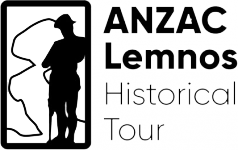
by anzac_admin | Jun 21, 2022
There is a French monument dedicated to the dead of the Gallipoli campaign in the center of the cemetery that has been erected on the initiative of the veterans’ associations. It is quadrangular and built of local black stone. It has a width at the base of 5 m, a base height of 0.65 m, and a total height of 6 m. On its main side, the north one, there is the inscription: “Pour la France 1915-1916″ (”For France 1915-1916″) and there is an insert plaque indicating: “A nos camarades morts pour la France. Leurs freres d’Armes. Pelerinage du 12 Juin 1930 ” (“To our comrades who died for France. Their comrades-in-arms. Pilgrimage of June 12, 1930”). The other two sides show the years 1915 and 1916.

by anzac_admin | Jun 20, 2022
At the entrance of Portianou village, the house of Vasilikos stands dominant. This house was used as accommodation and as a center of administration for both the French and the British. It was one of the few mansions located on the island outside of Moudros, built in the early 20th century and according to the testimonies of the locals, the First Lord of the Admiralty of the United Kingdom, Winston Churchill, stayed there during his visit in Lemnos. Nevertheless, the British records do not mention Churchill’s stay at Portianou village but instead the British Minister of War Lord Kitchener and General William Riddell Birdwood, who had disembarked in October 1915 at Moudros bay and toured the whole island, including Portianou village.

by anzac_admin | Jun 20, 2022
A British monument has been erected at one end of the East Moudros cemetery in honor of all the dead of the Dardanelles campaign. It is made of black granite and has a quadrilateral shape. Its base consists of four steps. The main part of the monument has dimensions of 1.45×1.45 m. and bears the inscription: ” To the Immortal Memory of those who died for the Empire, Dardanelles Campaign 1915-1916”. It then bears a four-sided obelisk and it is crowned with a cross.

by anzac_admin | Jun 19, 2022
The Information Center for the History and Maritime Tradition of Moudros was created in the building of the old school of Moudros, which was built at the end of the 19th century and was used as a primary school and as a justice of the peace. It was built with stones and carved cornerstones and preserves architectural elements of neoclassicism. The mission of the Information Center for the History and Maritime Tradition of Moudros is to highlight the strategic importance of the region both during the Balkan Wars and the liberation of the North Aegean islands, and during the First World War, when it served as the base of the Entente for the Gallipoli campaign.
The Information Center of the History and Maritime Tradition of Moudros aims, with the use of a wide selection of material, the objects it exhibits, the audiovisual projections, and its interactive applications, to inform the visitors about the two important historical periods of the Balkan Wars and the Gallipoli campaign, where Moudros played an important role. Visitors have access to documents of the time directly linked to the place and its history while gaining a complete picture of its importance to the ANZAC expeditionary force. Thus, the Center is a connecting link, both between the other respective infrastructures of Lemnos and also with the veterans of ANZAC and their descendants who visit Moudros every year.
You can find more information on the website: https://moudros.gr/en/

by anzac_admin | Jun 18, 2022
The British built a pier known as the Australian Pier at a short distance from Moudros to disembark troops, ammunition, supplies, and food. For easier transportation, they built a small decauville rail line, which became a double line over the months. The line was used to connect the pier with the Anglo-French camps at Moudros. Wagons were driven by a Hawthorn Leslie 0-4-0 PM (Petrol Mechanical) 2’6 “petrol engine. There was also a crane on the rails and the 117th (Railway) Company, Royal Engineers, was in charge.





